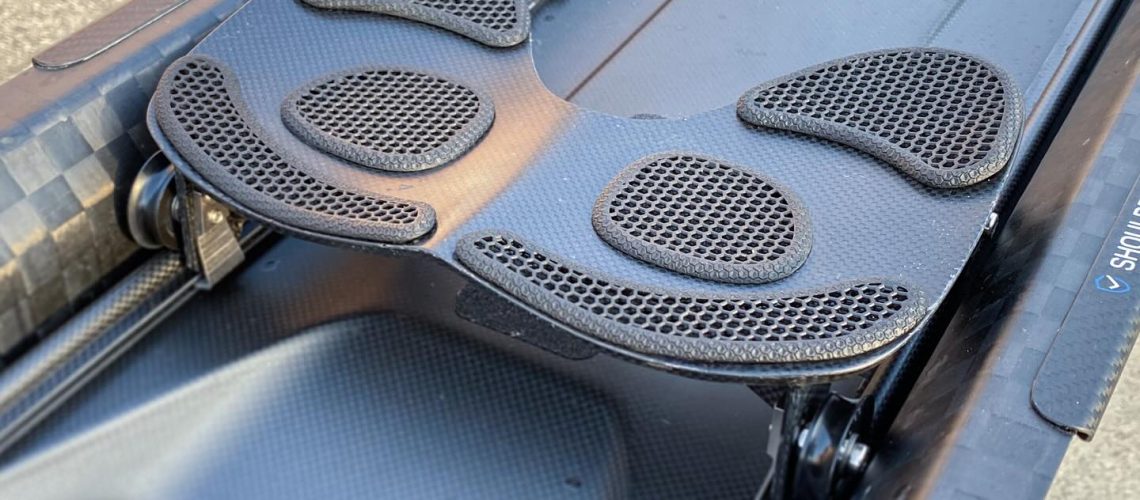The Seat, as explained by one of Filippi’s core engineers:
Specifically, we aimed to not only use new technologies to better transfer the load from the seat to the wheels but also to eliminate all hinged, pinned, or bolted joints. We replaced all of this with significantly higher rigidity by creating a monolithic piece: the chassis is no longer there. The wheels are directly attached to the seat without a metal chassis.
Adjustments are maintained, and we opted for inverse wheels as a guideline, meaning concave instead of convex. However, the option to choose the previous wheels, depending on the athlete’s preference, is still available. From here, we developed new convex rails made of carbon fiber with a technology that is far more advanced than those currently on the market, offering unparalleled lightness, with a carbon rail bottom part to better distribute the load across the decking. Even the bonding of the decking itself has been revised to better transfer the load to the hull and thus to the water.
The seat, as mentioned, is a single piece and significantly stiffened. This can result in less comfort but we are not here to be comfortable or take leisurely rides; we are here to win the Olympics, to win World Championships in development with the help of our physiologists. This change is analogous to what happened with bicycle saddles, where they moved from very soft to particularly stiff components. Why? Because the sensations that need to be transmitted must be rigid and immediate. This is how the boat’s stability is regulated. You will find significantly higher stability, but it will simply be your load that is better transferred to the boat. The natural adjustments your brain automatically applies will be directly transferred. The two rails will enable a far quicker slide and there will be no rises around a concavity where the seat finds its position of equilibrium. The position of equilibrium will be unique. Especially for sweep crews, where it is important to remain and transfer the load in a rigid manner, the new rails will improve your performance.
The study was conducted comprehensively: technology, materials, technique, load transfer. We sought the best material that could adapt better to your anatomical surfaces, and we chose a latex, developed with 3D technology. We have various solutions: in pieces, whole, or other options, which are variants that we are gradually developing and providing to our athletes. So, the athletes themselves will seek to improve and will be able to request, given the 3D technology, the customization of their seat so that for top-level and maximum performance, even this aspect is not left to chance.
Not a neoprene from top to bottom with constant density, but everything is organized, concentrated, and with variable density at every point of the seat to allow you the most rigid possible load transfer and optimization of your comfort against, unfortunately, performance. So, comfort versus load transfer.
Another interesting aspect is the simplicity of detaching the seat. It is no longer approached by hitting and hammering as it used to be archaically done. Now, with two slots on each rail, the seat is detached very simply, placed by moving it to the other slots, and slid inside to remove it in the same way. The interesting thing is that it cannot come off because, to do so, all the inclinations would have to be in the same direction, exactly in the position of the slots, and then there would have to be a sliding motion followed by another rotation. Therefore, it is impossible for it to detach during rowing. However, detaching and attaching it by hand will be done very simply whenever you want, without scratching the boat or the rails or deforming everything as tended to happen in the past.
A small highlight is the height adjustment. Now the wheels are completely independent, each can be adjusted on its own, and we have three adjustment holes that allow for about two centimeters of height. These three holes can also be used in a non-parallel manner on the boats, allowing for a variation of the angle between the front and rear of the seat or any other choice you may prefer.
This is all done with the goal of providing you with all possible adjustments without compromising—since the wheels are rigidly fixed through the holes and no longer supported by a chassis—the direct transfer of the load. This is the significant innovation of the new seat.




